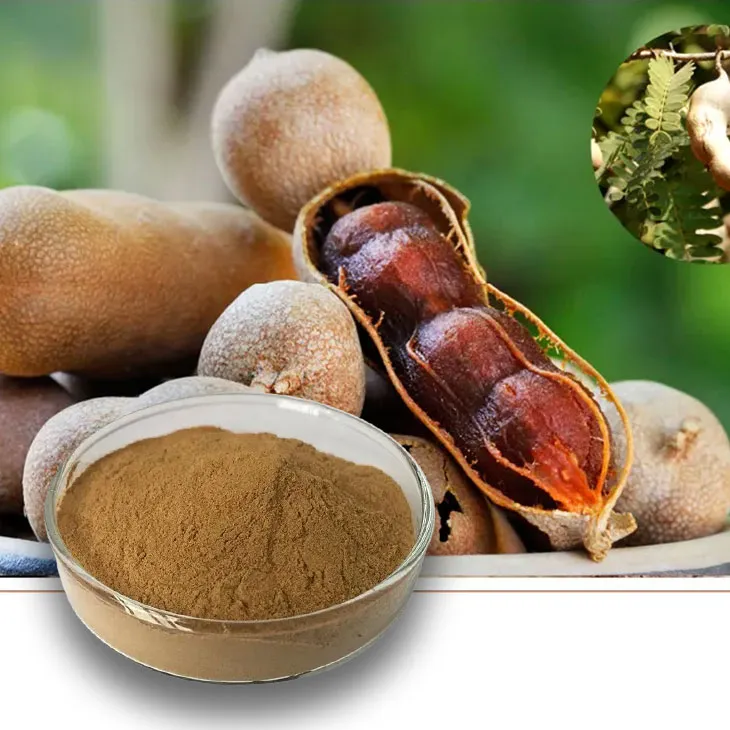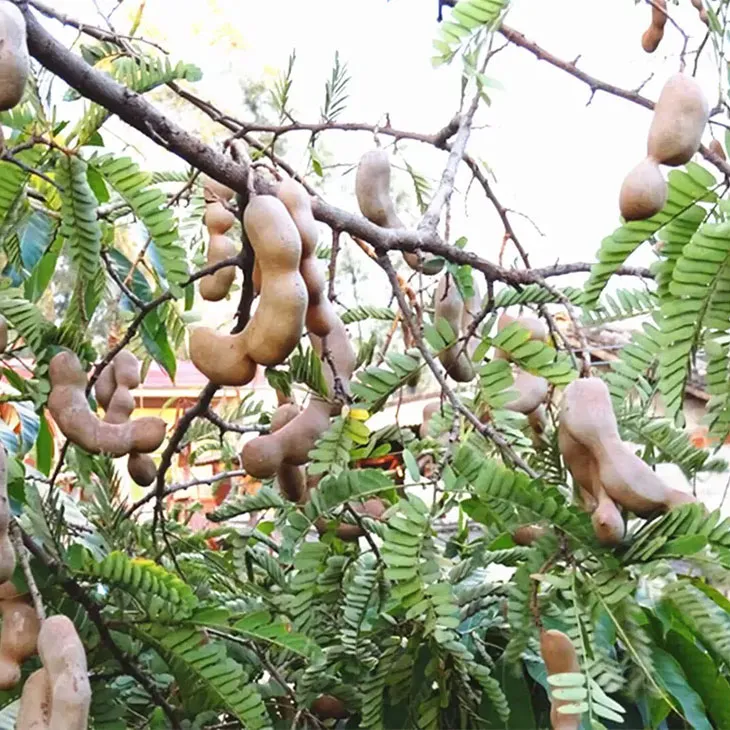- 0086-571-85302990
- sales@greenskybio.com
Tamarind Extract Powder: Nature's Best - Kept Secret.
2024-11-13

Introduction
Tamarind extract powder is a remarkable substance that has been overlooked by many in the modern world. It is a product that nature has bestowed upon us, yet it remains a relatively unknown wonder. This article aims to uncover the various facets of this amazing powder, from its nutritional value to its culinary uses and traditional medicinal applications.

Nutritional Profile
Tamarind extract powder is a rich source of nutrients. It contains a variety of vitamins, minerals, and antioxidants that are beneficial for our health.
Vitamins
One of the significant vitamins present in Tamarind extract powder is vitamin C. Vitamin C is essential for the growth, development, and repair of all body tissues. It is also involved in many body functions, such as collagen formation, iron absorption, and the immune system. Another vitamin found in tamarind is vitamin B complex. The B vitamins play crucial roles in energy production, cell metabolism, and maintaining healthy skin, hair, and eyes.
Minerals
The powder also contains important minerals. Potassium is one of the key minerals in tamarind extract powder. Potassium helps in maintaining proper heart function, regulates blood pressure, and is involved in muscle contractions. Additionally, tamarind contains calcium, which is vital for strong bones and teeth, as well as magnesium, which is necessary for enzyme function, nerve transmission, and muscle relaxation.
Antioxidants
Tamarind extract powder is rich in antioxidants. These antioxidants help in protecting our cells from damage caused by free radicals. Free radicals are unstable molecules that can cause oxidative stress in the body, leading to various diseases such as cancer, heart disease, and neurodegenerative disorders. The antioxidants in tamarind, such as flavonoids and polyphenols, can neutralize these free radicals, reducing the risk of such diseases.

Culinary Uses
Tamarind extract powder has a unique tangy flavor that makes it a valuable ingredient in various cuisines around the world.
Asian Cuisine
In Asian cuisine, tamarind is widely used. In Thai cuisine, for example, tamarind paste (made from tamarind extract powder) is a key ingredient in many dishes such as pad thai. The tangy flavor of tamarind adds a distinct taste to the stir - fried noodles, along with the combination of sweet, sour, and spicy flavors. In Indian cuisine, tamarind is used in curries, chutneys, and pickles. Tamarind chutney, for instance, is a popular accompaniment to snacks like samosas. It provides a sweet and sour flavor that complements the savory and spicy nature of the samosas.
African Cuisine
African cuisine also makes use of tamarind. In some West African countries, tamarind is used to flavor stews. The sourness of tamarind helps to cut through the richness of the meat and vegetables in the stew, creating a more balanced and flavorful dish. Tamarind is also used in making traditional drinks in Africa. These drinks are not only refreshing but also offer the nutritional benefits of tamarind.
Latin American Cuisine
In Latin American cuisine, tamarind can be found in some sauces and marinades. For example, in Mexican cuisine, tamarind - based sauces can be used to accompany grilled meats or added to salsas for an extra layer of flavor. The tangy taste of tamarind pairs well with the spicy and smoky flavors often found in Latin American dishes.

Traditional Medicinal Uses
Tamarind has a long history of use in traditional medicine across different cultures.
Aiding Digestion
One of the most well - known traditional uses of tamarind is for aiding digestion. Tamarind contains dietary fiber, which helps in promoting regular bowel movements. It also has natural enzymes that can assist in breaking down food in the digestive tract. In traditional Ayurvedic medicine in India, tamarind has been used for centuries to relieve constipation and improve digestion. Consuming tamarind extract powder or its products can help in soothing an upset stomach and enhancing the overall digestive process.
Reducing Inflammation
Tamarind also has anti - inflammatory properties. The antioxidants present in tamarind, such as flavonoids, can help in reducing inflammation in the body. Inflammation is associated with many chronic diseases, such as arthritis, diabetes, and heart disease. By reducing inflammation, tamarind extract powder may play a role in preventing or managing these diseases. In some traditional medicine systems in Africa, tamarind has been used topically to reduce inflammation in skin conditions like rashes and minor burns.
Other Potential Health Benefits
There are other potential health benefits associated with tamarind extract powder. Some studies suggest that it may have anti - diabetic properties. Tamarind may help in regulating blood sugar levels by improving insulin sensitivity. It may also have a role in maintaining healthy cholesterol levels. The fiber and other compounds in tamarind can potentially help in reducing LDL (bad) cholesterol and increasing HDL (good) cholesterol levels. Additionally, tamarind has been studied for its potential anti - microbial properties, which could help in fighting against certain bacteria and fungi.

How to Incorporate Tamarind Extract Powder into Your Diet
If you want to enjoy the benefits of tamarind extract powder, there are several ways to incorporate it into your diet.
In Beverages: You can add a small amount of tamarind extract powder to your smoothies, juices, or even make a tamarind - based tea. For example, to make a tamarind tea, steep a teaspoon of tamarind extract powder in hot water for about 5 - 10 minutes. You can add honey or lemon for additional flavor.
In Sauces and Dressings: Use tamarind extract powder to make unique and flavorful sauces and dressings. For a simple tamarind sauce, mix the powder with some water, sugar, and spices like ginger and chili. This sauce can be used as a dip for spring rolls or as a dressing for salads.
In Baked Goods: Tamarind extract powder can also be added to baked goods. You can add it to muffin or cake batters for a tangy twist. Start with a small amount, about half a teaspoon for a standard muffin recipe, and adjust according to your taste.
In Main Dishes: Incorporate tamarind extract powder into your main dishes. If you are making a stir - fry, add a teaspoon of the powder along with other seasonings. It will add a new dimension of flavor to your dish. In a slow - cooked stew, the powder can be added towards the end of the cooking time to enhance the flavor.
Conclusion
Tamarind extract powder is truly nature's best - kept secret. It has a rich nutritional profile, offers unique flavors in the culinary world, and has a long history of use in traditional medicine. By exploring and incorporating this amazing powder into our lives, we can not only enjoy its delicious taste but also potentially reap its many health benefits. Whether it is in our diet, in traditional remedies, or in the development of new products, tamarind extract powder has a great deal of potential waiting to be discovered.
FAQ:
What are the main nutrients in tamarind extract powder?
Tamarind extract powder is a great source of vitamins, minerals and antioxidants. However, specific vitamins may include vitamin C, among others, and minerals like potassium. The antioxidants help in protecting the body's cells from damage.
How does tamarind extract powder enhance the flavor of dishes?
Tamarind extract powder imparts a unique tangy flavor to dishes. This tanginess can add a new dimension of taste, making the dish more interesting and complex. It can be used in various cuisines, for example, in Asian cuisines, it might be used in curries or sauces to give a sour - sweet and tangy note.
What are the traditional uses of tamarind extract powder in medicine?
Tamarind extract powder has been used for centuries in traditional medicine. It is believed to aid digestion by perhaps helping in the breakdown of food. Also, it is thought to have anti - inflammatory properties, which could potentially help in reducing swelling or pain in the body.
Why is tamarind extract powder still relatively unknown?
There could be several reasons for tamarind extract powder being relatively unknown. One reason might be that it is not as widely promoted as other more common food ingredients or supplements. Also, in some regions, it may be a local ingredient that has not yet gained global popularity. Additionally, there may be a lack of extensive research in comparison to more mainstream products.
How can one incorporate tamarind extract powder into their diet?
One can incorporate tamarind extract powder into their diet in various ways. It can be added to smoothies for an extra tangy flavor and a boost of nutrients. In cooking, it can be used in marinades for meats, added to soups or stews, or used in baking to add a unique flavor to cakes or cookies. It can also be used to make a tangy salad dressing when mixed with oil, vinegar and other seasonings.
Related literature
- The Nutritional and Medicinal Properties of Tamarind Extract"
- "Tamarind in Culinary Traditions: A Comprehensive Study"
- "Uncovering the Health Benefits of Tamarind Extract Powder"
- ▶ Hesperidin
- ▶ citrus bioflavonoids
- ▶ plant extract
- ▶ lycopene
- ▶ Diosmin
- ▶ Grape seed extract
- ▶ Sea buckthorn Juice Powder
- ▶ Beetroot powder
- ▶ Hops Extract
- ▶ Artichoke Extract
- ▶ Reishi mushroom extract
- ▶ Astaxanthin
- ▶ Green Tea Extract
- ▶ Curcumin Extract
- ▶ Horse Chestnut Extract
- ▶ Other Problems
- ▶ Boswellia Serrata Extract
- ▶ Resveratrol Extract
- ▶ Marigold Extract
- ▶ Grape Leaf Extract
- ▶ blog3
- ▶ blog4
- ▶ blog5
-
Organic Tongkat Ali extract powder factory.
2024-11-13
-
How to make powder with ashwagandha extract.
2024-11-13
-
Rosehip extract manufacturers from China.
2024-11-13
-
The best cat's claw extract in nature.
2024-11-13
-
Chinese Dandelion Leaf Extract Suppliers.
2024-11-13
-
Marigold Extract
2024-11-13
-
Fenugreek Extract Powder
2024-11-13
-
Cassia Seed Extract
2024-11-13
-
Green Tea Extract
2024-11-13
-
Garcinia Cambogia Extract
2024-11-13
-
Carrageenan Extract Powder
2024-11-13
-
Agaricus Blazei Extract
2024-11-13
-
Lemon Balm Extract
2024-11-13
-
Withania Somnifera Extract
2024-11-13
-
Resveratrol extract
2024-11-13





















